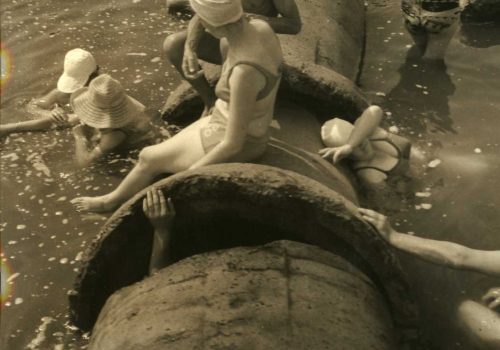The CRP / dedicates a solo exhibition to the Ukrainian artist Boris Mikhailov, international figure of contemporary photography. Echoing the industrial history of the region, he chose to present in the CRP gallery / the series Promzona, produced in 2011 for the Kiev Biennale and shown for the first time in an institution in France, and the Salt Lake series completed in 1986.
Boris Mikhailov is an artist in perpetual invention able to start new formal practices in the 1960s with the series Yesterday’s Sandwich (1966-68), to stage the tramps of Kharkov in a real urban phantasmagoria in Case history (1997- 98). Through the two series presented in the exhibition, the artist plunges us into his national history, from the Soviet past to the current Ukraine. A sensitive, nostalgic but sharp and committed vision, he proposes a work without concessions incarnating at the same time a ferocious observation of the human and the setting in images of History, that of the former Soviet block, of its great hours to its collapse to the unfulfilled democratic promises of capitalist openness.
The artist revisits with his lens places anchored in his own past. Promzona in 2011 shows a site where he worked as an engineer forty years ago in Kharkov, Ukrainian industrial jewel near the Donbass coalfield. Salt Lake is a photographic series made in 1986 in Slavyansk, the home town of his father in Donbass.
The views of the factories testify to the still active traces of the past of Kharkov, giant metallurgical workshop of the Soviet Union and now of Ukraine from which come out in large numbers since the 1920’s equipments and machines. These industrial complexes are the survival of a mythical age when the Revolution was carried by the power of industry, where artists extolled the beauty of machines. Futurism and Constructivism with Alexander Rodchenko, Vladimir Mayakovsky, represented the art of the new Russia. Painting, architecture, photography offered a geometric construction of space by highlighting the structuring importance of the line and the dynamism of forms, a vision close to the Cubist aesthetic. The circular compositions of Promzona are not without evoking by formal analogy the tondos of Braque and Picasso. He deconstructs the industrial shot by choosing his framing angles and his points of view. The arrangement of the planes and lines creates a geometric beauty. Footbridges, ladders, platforms build an air route in the heart of the assemblies of pillars and pipes. By the effect of low angle shot, the eye is drawn towards the sky whose azure contrasts with the black of the beams and the rust color of the enormous pipes. A human silhouette shows the ladder, a worker in orange jumpsuit is suspended on a sloping plane like a tightrope walker or those workers hung on the beams by Fernand Léger in his large canvas of 1950 Les Constructeurs. Actor of a mechanical ballet on a scene made of angles and intersecting axes, the man is a cog of the beautiful machine, “Krasnaya Mashina”.
Hearts are like engines, the soul a subtle explosion engine (Vladimir Mayakovsky, Listen if you light the stars, 1918).
Salt Lake is the chronicle of a few hours at the water’s edge. Slaviansk is a spa resort in Donbass renowned for the therapeutic benefits of its salt water and mud. We see bathers clustered in happy groups, they are lying on the shore, smear themselves with mud, chatting in a relaxed and family atmosphere. It is a sequence of popular and simple pleasures that can recall the cinema of Marcel Carné, Nogent, Sunday Eldorado, 1929 or Berlin Robert Siodmak Men, Sunday, the same year. The bodies of the bathers are ordinary, often pusgy and chubby, far from the aesthetic canons obligatory in Soviet art to represent the new man. Soviet bodies are thus shown to be raw and vulnerable without the heroic tidings of propaganda. Nearby, the chimneys of a factory spew their smoke, in fact salt is extracted from the salt lake to make soda. A huge pipe coming from the factory releases hot water into the lake itself. High-voltage pylons, rails are looming on the horizon without interfering with the carefreeness of the curists sitting on the pipe as on a jetty. In a very critical way, one observes the incongruous presence of industry in this Soviet Nice and the imprint of the productive apparatus on the leisure of the people. Each shot is captured in the flow of quiet days in Slavyansk. Paradoxically, there may be enchanted parentheses in the shadow of a dictatorship. The choice of sepia prints envelops these views with a nostalgic atmosphere retrospectively confirmed by the news. Indeed, Slaviansk is today a battlefield in the conflict that makes violent confrontation between the Ukrainian army and the pro-Russian separatists.
In Boris Mikhailov, photography is what remains of a vanished continent and what connects us to him: “He builds the haunted house of the Soviet world, a strange collection of images that each bear the mark of a collective hope, intimate dreams, forgotten sensations1 ”
1 David Teboul, Boris Mikhailov I have been here one day, Nicolas Bourriaud, Notes on Boris Mikhailov, The Presses of the Real, 2011, p. 12
Muriel Enjalran, Commissioner and Director of the CRP /
Boris Mikhailov – The Soul, a subtle blast engine
December 8 to February 24, 2019
CRP / Regional Center for Photography Hauts-de-France
Place des Nations
59282 Douchy-les-Mines
www.crp.photo
















